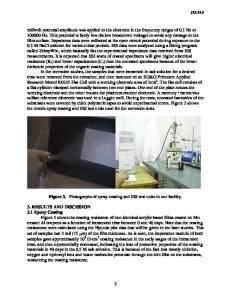Characterization of AgInSbTe-SiO 2 Nanocomposite Thin Film for Hydrogen Gas Sensor Applications
- PDF / 788,750 Bytes
- 6 Pages / 612 x 792 pts (letter) Page_size
- 109 Downloads / 306 Views
Characterization of AgInSbTe-SiO2 Nanocomposite Thin Film for Hydrogen Gas Sensor Applications Ching-Hung Wang, Kuo-Chang Chiang, Tsung-Eong Hsieh Department of Materials Science and Engineering, National Chiao Tung University, 1001 Ta-Hseuh Road, Hsinchu, Taiwan 30010, R.O.C. ABSTRACT Hydrogen (H2) sensing property of AgInSbTe (AIST)-SiO2 nanocomposite thin film prepared by target-attachment sputtering method was investigated in this work. The sample subjected to a 400°C-annealing for 90 sec exhibits a significant sensitivity (58.9 %) and short response time (75 sec) upon the exposure to an ambient containing 200 ppm H2 at 75°C. The gas sensing capability is ascribed to the presence of antimony oxides, e.g., Sb2O3 and Sb2O5, in nanocomposite layer which provide the charge carriers for sensing reactions. Moreover, the high specific-surface-area (SSA) feature of AIST nanocrystals in nanocomoposite layer provided numerous sites for reduction/oxidation reactions and thus a good H2 gas sensing property can be achieved. INTRODUCTION Hydrogen gas is a promising energy sources with versatile applications [1]; however, its safety in utilization is an essential concern due to its high flammability and explosive property. Accurate and fast detection of H2 gas leakage is thus required for the realization of H2-related applications. The sensing behaviors are usually associated with the electrical conductivity of active materials. For instance, when oxygen vacancies form in the oxides or ionic compounds, electrons are simultaneously generated to induce the n-type conducting behavior and hence imply a change in electrical conductivity [2]. The sensing capability can thus be ascribed to the charge transfer in between the active layer and absorbates when H2 gas molecules are absorbed on the surface of active layer, inducing a depletion or accumulation of charges near the active surface [3]. Presently, the metal-oxide-semiconductor (MOS) type gas sensors based on SnO2 [4], WO3 [5] and TiO2 [6] are widely studied and the H2 sensing behaviors related to the reduction/oxidation reactions induced by gas adsorption at temperatures ranging from 200-400°C have been reported. However, such a high-temperature reaction feature is adverse to the power consumption and device integration. In order to achieve high H2 sensitivity, stability and low operational temperature, modification of conduction behaviors by doping in above-mentioned oxides has been proposed. Nevertheless, this would complicate the sample synthesis process and a sintering at temperature above 600°C is usually required to form the crystalline nanostructure for ultrahigh gas sensitivity
and fast response. Further, the noble-metal based materials are relatively expensive and will increase the production cost. New materials and simple device fabrication methods are hence required for future development of H2 gas sensors with satisfied properties. AIST-SiO2 nanocomposite was adopted for the H2 gas sensor fabrication due to the fast phase-change rate and comparatively low recrysta
Data Loading...










